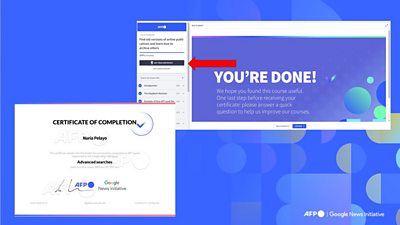
Fact checkers use traditional journalism techniques to speak to witnesses and check evidence, but they often use digital tools too. Many of these are useful across the newsroom to help avoid misinformation and work more efficiently.
We recently created for reporters to sharpen their digital skills, with examples and tips from our global fact-checking team. The courses are open to all journalists and journalism students, with the support of the Google News Initiative.
Here are some top tips for fact-checking from AFP.

Read the comments
Fact-checking is a public service, so it’s important to listen wherever people are communicating. Have open channels where people can send you tips and ask questions. Respond to feedback in a timely manner. Be sure to read the comments on social media posts to find others who are pointing out mistakes and linking to proof of why something is incorrect.
Collect the evidence first
A claim might appear obviously misleading, but you cannot publish a fact check if you do not have objective sources and sometimes visual evidence to show that it is wrong. Start with basic checks, like a reverse image search to see if a picture or video has appeared online before, or an advanced search on the web and social media. Links to websites, street maps, and online documents can be used as evidence. Your readers should be able to follow all the steps you take. It can be frustrating to drop a claim or keep a fact check on hold for as long as it takes to gather all the proof, but it is necessary. When providing a link to a claim that is false, provide a web archive rather than the original. This will avoid sending traffic to suspect websites and keep proof that the content existed online. We use several archiving sites including the Wayback Machine.
Keep to the point
Good fact checks are precise, unemotional and stay on topic. Avoid opinion and check your own confirmation bias – do you have a pre-existing opinion about something you are planning to check? Avoid colourful language, puns and irony, which may not translate into other cultures. Anyone can fall for a false claim, and it is unlikely someone will be open to being corrected if you suggest they were foolish to believe something in the first place. Double or triple check before publishing and correct errors quickly and transparently.
Provide context
Fact checks should provide context high up in the story. That may include explaining what is known about unfolding events, the local relevance of a claim, or pointing to the accounts behind the claim – particularly if they have a pattern of sharing misleading information. When news breaks, we often see a mixture of actual images and older, misleading pictures being shared. For example, we have seen realistic-looking footage from video games being shared in posts claiming to show fighting in Ukraine. Readers need context about real battles going on, as well as verification of specific misleading images which distort the full picture.
Anticipate harassment
Fact checkers are particularly vulnerable to harassment. The more you can prepare to deal with attacks the better. Create a checklist of how your organisation will address harassment. Have a secure case folder to store all the evidence. If an attack is on a piece of work, carefully check all the accusations. If a mistake was made, it must be transparently corrected. Editors need to pay attention to the mental health of their staff and routinely check in to monitor their well-being. Consider each case individually and work to minimise harm to staff while also addressing harmful misinformation.

More from the Trusted News Initiative
- How not to amplify bad ideasAmplification is the idea that journalists bring undue attention to things that are fringe, extreme but very harmful. So how can we avoid it?
- Labelling lies: The practical challengesHow should debunked or fact checked information be presented?
- Is seeing believing? A visual debunking masterclassA walk through the steps necessary to check video and photographs with real examples.
